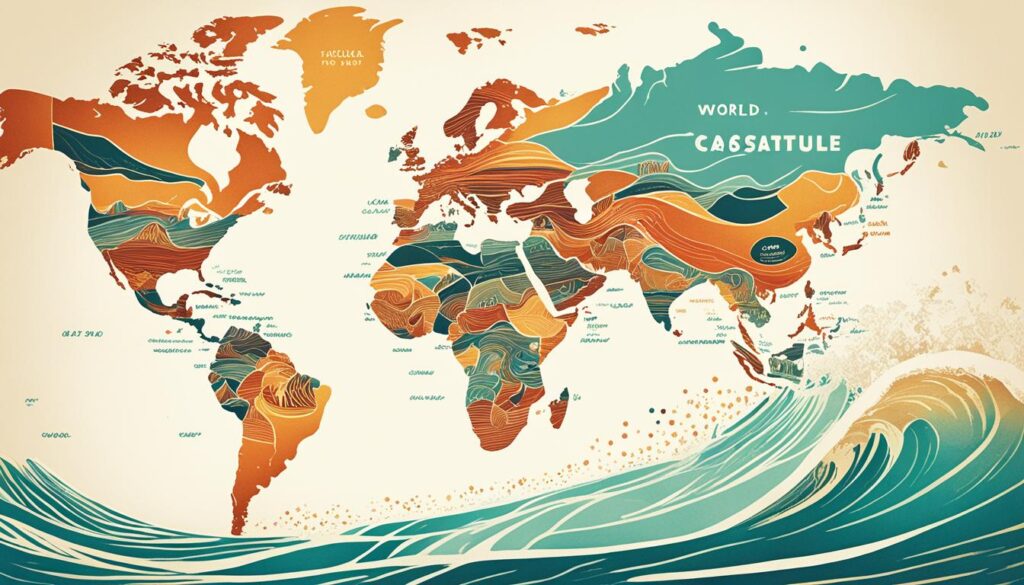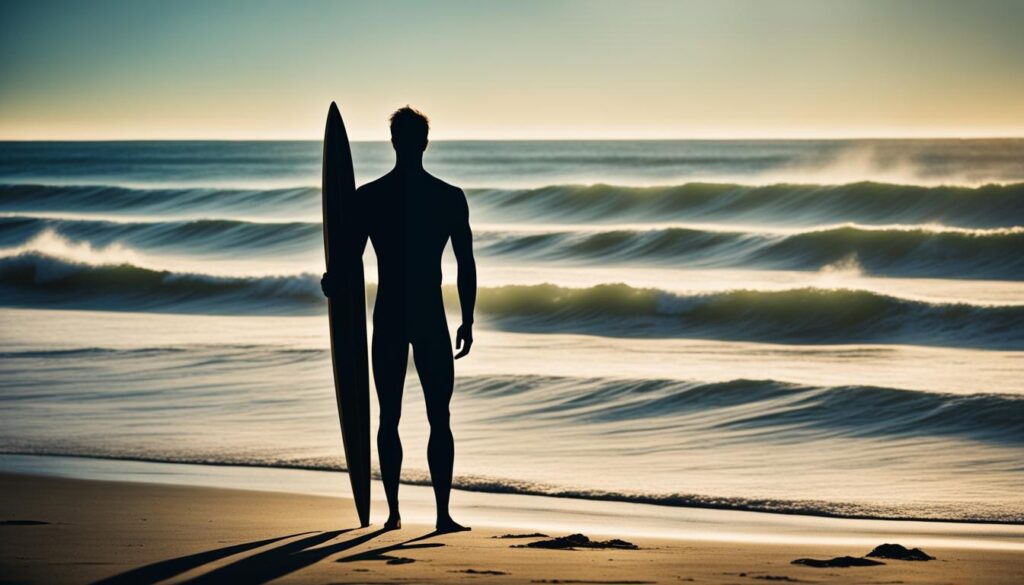Have you ever wondered when surfboard fins were first invented? The evolution of surfboard design has brought significant advancements over time, but the origins of fins may surprise you. Delve into the history of surfboard fins to discover how they have shaped the sport of surfing and revolutionized the way we ride the waves.
The history of surfboard fins dates back to ancient times, with the Hawaiian culture of he’e nalu being the birthplace of modern surfboard design. From there, surfboard fins have undergone numerous transformations and innovations, enhancing performance and allowing surfers to push the boundaries of what’s possible on a wave.
Are you ready to dive into the fascinating journey of surfboard fins? Join us as we explore the cultural origins of surfboard fins, the worldwide expansion of the sport, the introduction of fins and fiberglass, the foam blanks and shortboard revolution, and the experimentation with different fin configurations.
Key Takeaways:
- The history of surfboard fins can be traced back to Hawaii, where the culture of he’e nalu birthed modern surfboard design.
- The worldwide expansion of surfing in the early 1900s was influenced by Hawaiian legend Duke Kahanamoku.
- Innovations in the 1930s and 1940s introduced fins and fiberglass to surfboard design, enhancing stability and maneuverability.
- The introduction of foam blanks and the rise of the shortboard in the 1950s and 1960s revolutionized surfboard design.
- The 1970s and 1980s saw the exploration of different fin configurations, paving the way for modern surfboard design.
Pre-1900s – Cultural Origins
The cultural origins of surfboard fins can be traced back to the pre-1900s in Hawaii. The Hawaiians, known for their love of wave-riding or he’e nalu, used solid wood crafts called alaia for surfing. These traditional surfcraft ranged from 3′ to 20′ in length and were an integral part of Hawaiian culture, with both practical and ceremonial significance.
The alaia boards were not equipped with fins, requiring the surfer to rely solely on skill and balance to maneuver through the waves. This finless design provided a unique challenge to the surfers, demanding heightened control and precision.
English colonist Captain Cook, who arrived in Hawaii in 1778, was one of the first outsiders to witness the art of surfing. He observed the Hawaiian people riding their finless alaia boards with remarkable skill and grace. Captain Cook’s account of this ancient Hawaiian pastime provided early documentation of surfboard riding, shedding light on the cultural origins of this water sport.
The use of alaia boards was deeply intertwined with Hawaiian rituals and recreational activities. Surfing held significant social and spiritual value, connecting individuals with the ocean and the divine forces believed to inhabit it.
While the Hawaiian finless surfcraft of the pre-1900s laid the foundation for modern surfboard design, it would take further innovations and influences from different parts of the world to shape the evolution of surfboard fins.
1900-1920s – Worldwide Expansion
The early 1900s marked a period of worldwide expansion for surfboard design. After the United States annexed Hawaii in 1898, American settlers, inspired by the Hawaiian legend Duke Kahanamoku, played a pivotal role in popularizing surfing on the mainland. Duke Kahanamoku, known as the “Father of Modern Surfing,” introduced his unique surfboard shape and style to the world, leaving an indelible impact on the sport.

Kahanamoku’s surfboards, featuring a 10′ blunt-nosed and square-tail design, showcased both stability and maneuverability in the water. In 1914, Kahanamoku traveled to Australia, where he stunned locals with his surfing prowess. His visit played a significant role in introducing the sport to Australia, leading to the formation of a vibrant surf culture that continues to thrive to this day.
“Pacific swims champion, Duke Kahanamoku, with an 10′ board an plans surf trip. Picture shows the perfect pose of the National champion and olympic swimming official.” – The Sporting Judge
The Duke Kahanamoku’s influence in Australia sparked a wave of enthusiasm for surfing. Australians embraced the sport, with local enthusiasts experimenting with surfboard design and manufacturing. Australian surf culture began to flourish, leading to the establishment of surf clubs and competitions, further solidifying surfing as a beloved pastime.
Australian Surf Culture in the 1900s
Australian surf culture in the early 1900s was characterized by a deep appreciation for the ocean and a love for riding waves. Surf lifesaving clubs played an integral role in fostering community and promoting water safety. These clubs organized competitions and events, adding to the growing popularity of the sport.
The art of wave-riding quickly spread along the Australian coastline, with surfers exploring different beaches and perfecting their skills. Surfboard manufacturing evolved, with local craftsmen experimenting with new materials and designs. The surf-friendly conditions and passionate surf community paved the way for the development of iconic Australian surf brands that have withstood the test of time.
The Legacy of Duke Kahanamoku
Duke Kahanamoku’s pioneering efforts and his role in the worldwide expansion of surfboard design cannot be overstated. His passion for surfing and his influential surfboard designs introduced the sport to new audiences across the globe. Kahanamoku’s legacy lives on, and his contribution to surf culture, both in the United States and Australia, continues to inspire generations of surfers.
| Key Points | Details |
|---|---|
| American settlers in Hawaii | Influenced by Hawaiian legend Duke Kahanamoku |
| Kahanamoku’s surfboard design | 10′ blunt-nosed and square-tail |
| Kahanamoku’s visit to Australia | Introduced surfing to Australia in 1914 |
| Australian surf culture | Thriving surf clubs and competitions |
| Kahanamoku’s legacy | Inspires surfers worldwide |
1930s-1940s – Fins and Fiberglass
The 1930s and 1940s witnessed significant advancements in surfboard design, particularly in the introduction of fins and the use of fiberglass materials. These innovations revolutionized the performance and maneuverability of surfboards, paving the way for modern board designs.
One notable waterman who played a pivotal role in surfboard development during this era was Tom Blake. Blake pioneered the use of hollow wood surfboards, employing innovative construction techniques that provided surfers with enhanced control and responsiveness through turns. His hollow boards featured an internal framework and a layer of lightweight polyurethane foam, which improved buoyancy and board performance.
In addition to hollow wood surfboards, Blake is credited with affixing the first fin to a surfboard, a significant breakthrough in surfboard design. The fin added stability and improved maneuverability, allowing surfers to take their riding to new heights.
“The introduction of fins and fiberglass during the 1930s and 1940s marked a turning point in the evolution of surfboard design. It was a period of experimentation and innovation, driven by individuals like Tom Blake who had a profound impact on the sport.”
The use of fiberglass in surfboards gained traction during World War 2, as technological advancements allowed for its mass production. Fiberglass, being lightweight and durable, proved to be an ideal material for surfboard construction. Combined with the use of polyurethane foam cores, surfboards became lighter, more dynamic, and capable of handling larger waves.
Advancements in Surfboard Design during the 1930s-1940s
| Advancements | Description |
|---|---|
| Hollow Wood Surfboards | Introduced by Tom Blake, these boards featured a hollow construction with an internal framework and a layer of lightweight polyurethane foam, providing improved control and buoyancy. |
| Fin Attachment | Tom Blake affixed the first fin to a surfboard, enhancing stability and maneuverability while riding waves. |
| Fiberglass Construction | Technological advancements during World War 2 allowed for the mass production of fiberglass, resulting in lighter and more dynamic surfboards. |
The introduction of fins and fiberglass during the 1930s and 1940s laid the foundation for further advancements in surfboard design. These innovations not only improved performance but also inspired a new wave of experimentation and creativity among surfboard shapers and riders.
1950s-1960s – Foam Blanks and the Shortboard Revolution
The 1950s and 1960s witnessed a revolution in surfboard design, fueled by the introduction of foam blanks and the emergence of the shortboard. Renowned shapers like Dale Velzy and Gordon Clark were at the forefront of this transformation, pioneering the use of lightweight polyurethane foam cores.
By adopting foam blanks, surfboard craftsmen could create thinner and more maneuverable longboards, taking surfing performance to new heights. The use of foam blanks revolutionized the manufacturing process, making surfboards more accessible and affordable for surfers around the world.
During this era, a group of innovative designers pushed the boundaries of surfboard design even further. Bob McTavish, a renowned Australian shaper, introduced key advancements. McTavish experimented with shorter board lengths, leading the charge for what would become the shortboard revolution.
McTavish’s pursuit of increased performance and maneuverability inspired other influential designers, such as George Greenough and Dick Brewer. Greenough, renowned for his finless designs, revolutionized the concept of hydrodynamics with his “spoon” design. Brewer, on the other hand, experimented with various fin configurations and bottom contours, further enhancing board performance.
The introduction of foam blanks and the shortboard revolution marked a pivotal point in surfboard design history. It catalyzed a shift from traditional longboards to shorter, more dynamic boards, enabling surfers to explore new possibilities in wave riding.
Innovation at a Glance
| Shapers | Key Contributions |
|---|---|
| Dale Velzy | Pioneered the use of foam blanks in surfboard construction. |
| Gordon Clark | Further developed foam blank technology, making surfboards lighter and more affordable. |
| Bob McTavish | Introduced shorter board lengths, igniting the shortboard revolution. |
| George Greenough | Revolutionized hydrodynamics with his finless “spoon” design. |
| Dick Brewer | Experimented with fin configurations and bottom contours, enhancing board performance. |
The contributions from shapers like Bob McTavish, George Greenough, and Dick Brewer paved the way for modern surfboard design.
1970s-1980s – More Fins, Less Length
In the 1970s and 1980s, surfboard design underwent a thrilling phase of exploration and innovation. Surfers around the world were in search of faster, more progressive, and powerful surfing experiences, leading to significant advancements in board technology.
During this era, two groundbreaking fin configurations emerged as game-changers: the Bonzer and the thruster. The Campbell brothers introduced the Bonzer, a surfboard design featuring three fins. The Bonzer offered increased control, speed, and maneuverability, allowing surfers to push the limits of their performance in small to medium-sized waves.
In parallel, Simon Anderson revolutionized surfboard design with his introduction of the thruster. The thruster featured a three-fin setup that provided surfers with enhanced stability and the ability to execute more radical turns. The thruster quickly gained popularity and became the go-to fin configuration among surfers worldwide.
These innovative designs, pioneered by the Campbell brothers and Simon Anderson, marked a turning point in surfboard evolution. They paved the way for modern surfboard design, demonstrating that incorporating more fins and decreasing board length could unlock new levels of performance and control in the water.

